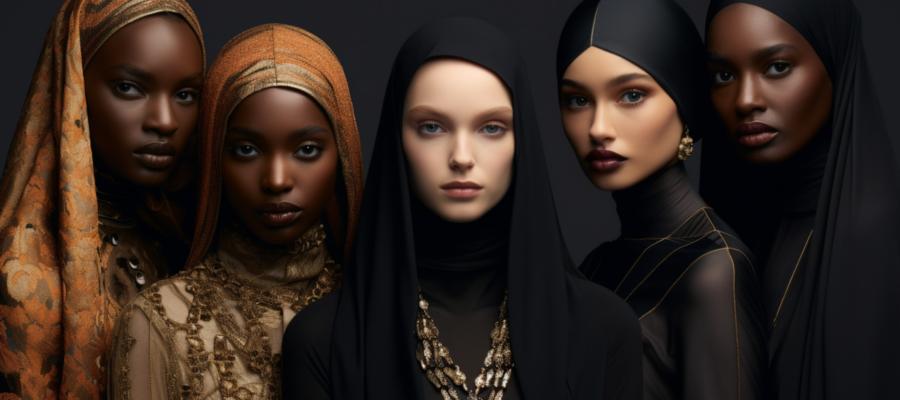Breaking Stereotypes: Diversity in Fashion Advertising

Step aside cookie-cutters, embrace the bounty of humanity
Picture a fashion advertisement. What do you see? Statuesque creatures of poise and grace, with legs that stretch from here to eternity, and cheekbones so sharp you could slice your morning toast with them. They are, in a sense, a fantasy - an idealized projection of what we, as a society, have come to covet. But I ask you, dear fashion fans, what of the other 99% of the population? The curvy, the short, the freckled, the gap-toothed, the disabled, and the beautifully non-binary? Thankfully, in this modern age, a new paradigm is dawning. Say farewell to the monotonous parade of identical faces and bodies, and hello to a diverse and fascinating array of models gracing our billboards and magazine pages.Defying the odds: Fashion's trailblazers
Although the fashion industry has stubbornly clung to its narrow standards of beauty for decades, there are those brave souls who have dared to defy convention. In the 90s, Kate Moss sprang onto the scene, with her slight frame and waifish features, sending shock waves through an industry dominated by Amazonian supermodels. A decade later, Sophie Dahl emerged, her voluptuous figure a stark contrast to the waifs of the time. Today, we have trailblazers such as Winnie Harlow, who proudly flaunts her vitiligo, and Hari Nef, the transgender model who has taken both the fashion and acting worlds by storm. These pioneers have shown us that beauty can be found in the most unexpected places, and that the fashion industry is richer for it.From tokenism to true representation
But the fight for diversity in fashion advertising is far from over. It's all very well to feature the odd 'alternative" model, but a truly inclusive landscape must do more than merely pay lip service to the notion of diversity. A smattering of freckles does not a diverse advertisement make. We need campaigns that celebrate the full spectrum of humanity, from race and ethnicity to body shape, sexuality, and ability.Take, for example, the groundbreaking 2014 campaign from &OtherStories, a brand under the H&M umbrella. The campaign featured a diverse cast of models, including transgender and disabled individuals, and was hailed as a breath of fresh air in an otherwise stifling climate of identikit advertisements. Or consider the 2016 campaign from Rihanna's Fenty Beauty, which showcased a truly multicultural cast of models, perhaps for the first time in the history of cosmetics advertising. These are the kinds of campaigns we need more of - campaigns that boldly challenge the status quo, and show the world that beauty comes in all shapes, sizes, and colors.
Practical advice: Embracing diversity in your own fashion campaigns
So, how can you, as a budding fashionista or marketing maven, ensure that your campaigns are as inclusive as possible? Fear not, for I have delved into the depths of my wisdom to bring you these pearls of advice:- Seek out diverse models: It may seem obvious, but the more diverse your models, the more diverse your campaign. Don't merely rely on the offerings of modeling agencies - be proactive in your search for fresh faces.
- Listen to your audience: Your customers will be your greatest source of inspiration. Pay attention to their feedback, and be prepared to adjust your campaigns accordingly. Remember, the fashion world is nothing without its fans.
- Collaborate with diverse creatives: Work with photographers, stylists, and makeup artists who share your vision for a more inclusive industry. Together, you can create campaigns that resonate with a wider audience.
- Be authentic: Never use diversity as a marketing gimmick, or you risk alienating the very people you hope to appeal to. Strive for a genuine celebration of all that makes us unique, and your campaigns will shine.
- Educate yourself: Understand the challenges faced by marginalized communities, and be sensitive to their concerns. By doing so, you will be better equipped to create campaigns that truly resonate with your audience.
Article kindly provided by foreverinfashion.org
Latest Articles
- Style That Works With Your Body, Not Against It
- Fashion Tourism on Wheels: Curated Shopping Routes Led by Chauffeur Guides
- The Charm of Certainty in a World of Indecision
- Can an Everyday T-Shirt Be Turned into a Modern Heirloom?
- Color, Ceremony, and the Psychology of Celebration
- Styling Graphic T-Shirts for Different Body Types
- Getting Kids to Wear Their Hats Without a Bribe or a Meltdown
- Mastering the Art of Being the Unnoticed Photographer
- Quiet Sportswear Moves Loudly
- Fashion's Most Misunderstood Color Is Brown
- Weight Matters When Cotton Gets Real
- SKU's Out for Summer: Why Your Warehouse Is Melting Down
- Ink as Accessory - How Tattoos Are Replacing Jewelry in Modern Style
- Decoding the Y2K Aesthetic with Style and Sanity
- Accessories
- Jewellery
- Footwear
- Skirts and Dresses
- Shirts and Blouses
- Beauty and Makeup
- Fashion Photography
- Sustainable Fashion
- Street Style
- Fashion History
- Fashion Business
- Fashion Styling
- Fashion Events
- Plus-Size Fashion
- Men's Fashion
- Women's Fashion
- Fashion Blogging
- Fashion Trends
- Fashion Retailers
- Fashion Tips and Advice
- Fashion Business Startups
- Fashion Around the World
- Lingerie
- Sportswear
- Weddings

